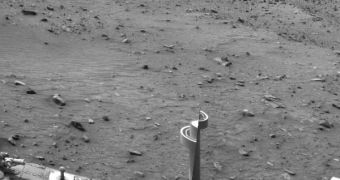Following Tuesday's attempt at moving the jammed rover Spirit, engineers and mission planners at the American space agency's Jet Propulsion Laboratory (JPL) have decided to upload a new set of commands into the robot's onboard computer earlier today. The machine has been stuck in a patch of loose soil known as Troy, which contains powder-like sand that no longer allows Spirit to move ahead uphill. Its wheels are buried up to their hubcaps in the terrain, which is one of the main reasons why it took more than six months for engineers to find the best extrication scenario, Space reports.
Their best bet is to make the robot backtrack from its current location, and to move back the way it came. The JPL team says that this maneuver will also allow it to make good use of the force of gravity, as Spirit is located on a slope with a 12-degree inclination. Moving the rover straight downhill runs the risk of trapping it in unfamiliar, rugged terrain. Therefore, it will drive backwards, and a little to the left, the scientists announce.
Things are made even more complex by the fact that the exploration robot has already been driving backwards for the past three years, as one of its front wheels has long since been rendered nonoperational. Additionally, images taken with the microscopic camera on Spirit's robotic arm have revealed that a rock may be located right below the machine's underbelly. If the wrong drive command is given, then the robot could settle on it, losing even the little amount of grip it currently has.
Tuesday's drive attempt, for example, ended a few seconds after it started, mostly because the sensors aboard the robot detected a tilt that exceeded the maximum allowed one. JPL experts say that they purposefully set very narrow limits on the machine's tilt, so as not to risk making matters worse than they already were. The extrication process, JPL MER Project Manager John Callas says, will take place in small increments. After a small drive, the rover will stop and image its surroundings, while engineers will assess the success of the maneuver.
As such, the extrication process could take weeks or even months, Callas warns. However, it will all be worth it if the rover is to be released from Troy. Spirit has been roaming the surface of the Red Planet since 2004, as part of a mission that was originally planned to last for no more than 90 sols, or Martian days. However, both this robot and its twin, Opportunity, proved to be extremely resilient, and even endured five winters on the planet. Both craft had special anniversaries recently. Opportunity exceeded the ten-mile marker in its drives, while Spirit reached 2,000 sols on the Red Planet. For further details of how the extrication process is going, keep an eye on this space.

 14 DAY TRIAL //
14 DAY TRIAL //